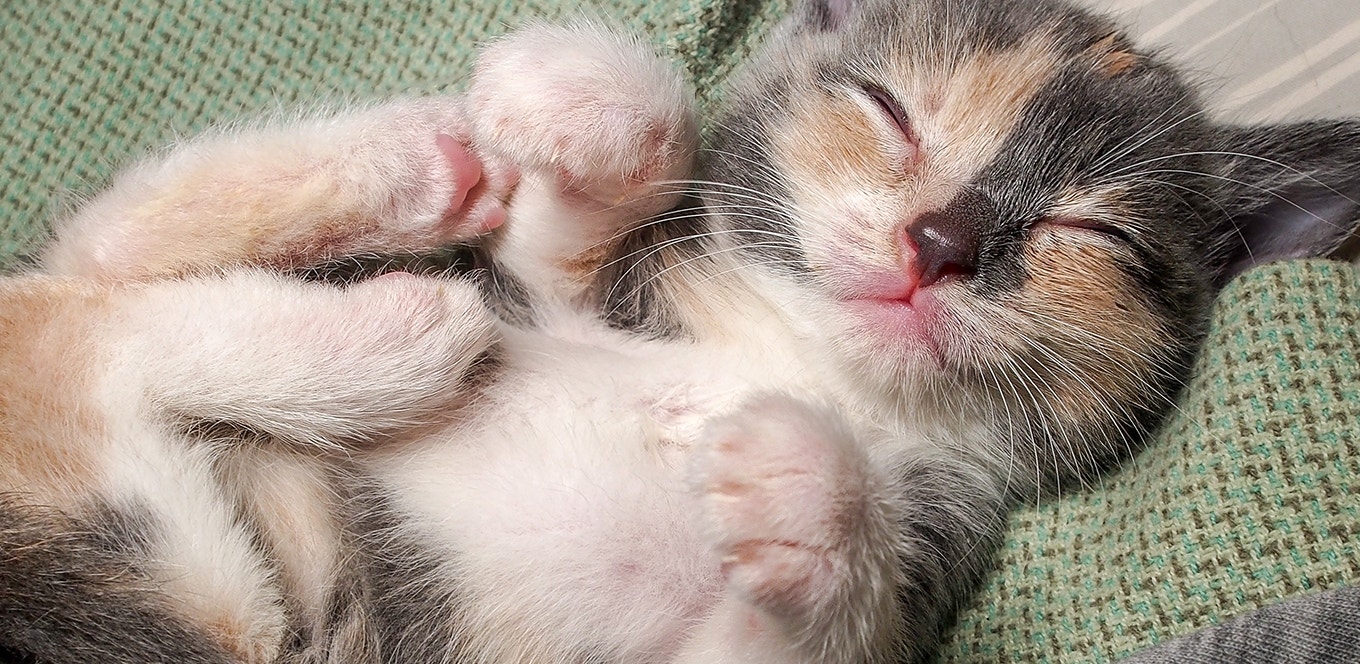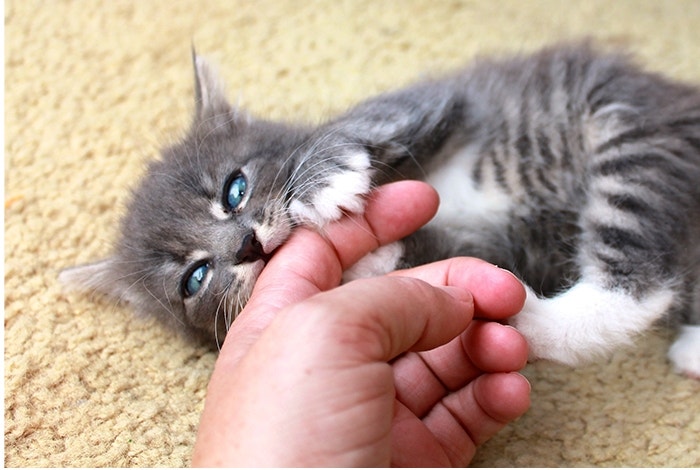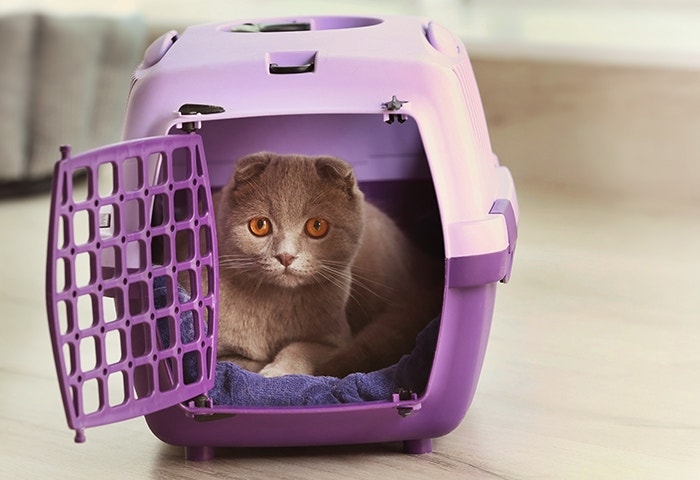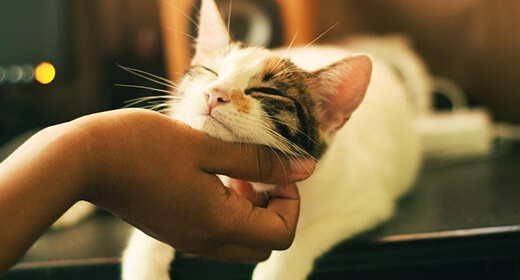

Your kitten is one of a kind, not to mention adorable. But training your li’l baby comes with some basic guidelines. Scroll on for a handful of our favorite kitten training tips.
Introduce your new kitten to their litter box as soon as they get home. Then always set your cat in their box right after meals and as soon as they wake up from naps.
And don’t forget to reward your kitten with a treat, toy or some extra love after they use it.
Kitty, meet litter.
Litter, meet kitty.
When Kitty forgets their manners and bites you or shows their aggressive side, say “ow” or “no” clearly and sternly.
Then slowly remove your hand — or other body part — from their razor-sharp clutches. Pick up your kitten, place them away from you, walk away and ignore them.
You can also redirect them to a feather wand or another toy or activity if you want. But that’s your call.
Ouch!
That’s my hand,
not a treat, tiny cat.
By giving your little feline lots of sturdy scratching posts throughout your house, especially where they like to hang out, you can save your favorite furniture from unwanted claw marks and damage.
Oh, and be sure to trim your kitten’s nails regularly.
Say it with me:
Sofas are NOT
scratching posts.
Teach your kitten that their cat carrier is a safe, comfortable place to chillax and feel protected.
Trust us, by making a carrier part of your fuzzball’s daily life, road trips and vet visits will be easier and safer for years to come.
Cozy up,
Buttercup.
It's midnight. Bring on the zoomies, furry one.
(Actually, please don’t.)
Want to stop your kitten from bouncing off the walls while you’re supposed to be deep in slumber land? Try these tips.
Have a long play session later in the evening.
Feed your feline a big meal of delicious, nutritious Opens a new windowIAMS™ Healthy Kitten or PERFECT PORTIONS™
Spend 15 minutes of purr-worthy snuggle time before you hit the hay.
Yep, it’s true! One of our favorite Opens a new windowstudies from the University of South Australia proved it.
To help train your kitten, pick the word that best describes them:
These anxious felines tend to run away when the doorbell rings and are fearful of new situations.
The key to training a skittish kitty? Practice lots of patience and never force them to face their fears, like meeting your house guests after they’ve already runaway and hidden.
Some call them nosy, but we call them fearless. Outgoing kitties are curious and adventurous. They love to explore and get into everything — and they sometimes act naughty because they’re bored.
One of the tricks to training an outgoing kitten is to give them lots of toys and actively play with them. It stimulates their mind and helps burn off energy.
“Bossy” best describes these kitties. They bully other cats (and even other pets) and hog things like food bowls, toys and litter boxes.
If your kitten fits this category, be consistently firm and make sure you play with them regularly so they have less energy to be aggressive.
You might also want to make sure your little CEO (Cat Executive Officer) has their own food bowl, water bowl and litter box.
Two words describe these felines: impulsive and erratic. Their behavior and moods are unpredictable, even if they’ve encountered the same situation before.
When training, never raise your voice — it’ll just ramp up your kitty’s nerves and make them more erratic.
Also, be sure to stick to a consistent daily schedule for feeding and playtime so your little fuzzball knows what to expect and doesn’t get stressed out.
This personality is every cat lover’s dream.
These sweeties can usually be found curling up against your shins, meowing loudly and purring away.
The key to training these kittens is to never yell and to socialize them early and often. That way, they’ll continue to be everyone’s best friend for life.
You had me at
meow, li’l feline.





Cats are known to be solitary creatures and enjoy spending time with themselves. However, as a pet parent, you must ensure that your cat remains healthy. It is advisable to keep an eye on your cat’s behaviour to detect a sudden change, even what it eats, and in how much quantity. A regular health checkup is one of the most basic yet essential steps to a cat care guide. Taking care of cats is comparatively easier than taking care of kittens. A diligently followed routine for cat care can also be quite helpful.
Medical care: Adult cats should be taken to the vet for a complete checkup at least once a year. This will ensure that your cat is in good health and will also catch any disease symptom overlooked by you.
Hygiene: Cats usually lick and clean themselves, but it is always advisable to bathe your cat every 4-6 weeks. Their crates should also be cleaned regularly to make sure they do not fall sick.
Feeding: Till the time your kitten is four months old, it can be fed three times a day. Post four months, you can begin the transition to feeding it twice a day. It is still advisable to consult a vet before deciding the frequency of the meals.
Dental care: Your cat’s dental care is just as important as yours. It is advisable to set a dental care routine right from its kitten phase. You can dip your gloved finger in a little toothpaste made for cats in its mouth to clean their teeth and gums. If your cat’s mouth smells bad, it may be an indication of a disease. So, book an appointment with your vet without any delay.
Socialising: You can get your cat to socialise too, but you have to keep a few things in mind. You may get down to its level to initiate contact and speak in a calm voice. You may also pat its head to let it get familiarised with your touch.
Now that you have brought your cat home, the next step is to comfortably settle it in your house. Housetraining might sound like a tedious task but it isn’t. With a little practise and lots of patience, you can easily housetrain your cat. Some of the most basic things to keep in mind while housetraining your cat include providing a proper litter box, spaying your cat, toilet training and cat proofing the house. Given below are some tips that may help you easily housetrain your cat:
Litter box: It is advisable to place the litter box in an easily accessible location. You should avoid moving the litter box unless necessary. And even if you have to move it, shift it a few inches every day. Also, keep in mind that your cat will not use a dirty or smelly litter box. Hence, scoop out the solid waste at least once a day and clean it using mild detergents.
Cat-proofing: It is important that you keep harmful things out of reach from your cat. First and foremost, tie up all loose cables and wires so that your cat won’t get tangled in them. Make sure candles and other flaming substances are kept at an unobtainable distance from the cat. If you use essential oils frequently, make sure your cats do not come in contact with them either, because certain ingredients in these oils may be toxic for your feline friend.
Spaying: Spaying your cat has several health benefits and ensures your cat lives a healthy life. You may fix an appointment to spay your kitten when it is as young as eight weeks old. If you have a cat, it is advisable to get it spayed before it reaches five months of age.
Toilet training: This is one of the major concerns of all cat parents. Here’s how you can toilet-train your cat with a few simple steps –
1) Place the cat’s litter box closer to the washroom.
2) Raise the height of the litter box a little every day.
3) Slowly, transition your cat to use the actual washroom every time it wants to go.
4) Give your cat a treat each time it uses the washroom. This will encourage good behaviour.
Taking care of your cat’s health comes first in the cat care guide. Even though cats lick and self-groom themselves, they cannot get better on their own if they contract the following diseases:
Vomiting: This is one of the most common health issues in cats and is caused by various factors. Hairballs, eating something inedible, or a urinary tract infection are some of the reasons why your cat may be vomiting.
Feline Lower Urinary Tract Diseases (FLUTD): Both male and female cats can contract FLUTD and its main cause is obesity or only eating dry food. Some of the symptoms of FLUTD are bloody urine, crying while urinating, straining to pee, licking around the urinary area due to pain, dehydration and vomiting.
Diarrhoea: Cancer, infection, allergy and bad food can be the causes of diarrhoea. It is advisable to give your cat a lot of fresh water to drink if it has diarrhoea.
Tapeworms: Tapeworms can cause extreme discomfort to your cat as they reside in its intestines. You can spot tapeworms with your naked eye in your cat’s stools. The symptoms of worms are vomiting and weight loss.
Feline Immunodeficiency Virus (FIV): This virus can make the immune cells attack the white blood cells in the cat’s body. This gradually weakens the cat’s immune system. FIV’s symptoms are poor coat condition, persistent diarrhoea, seizures, eye problems, lack of appetite, and recurring fever.
If you notice unaccountable minor changes in your cat, then it is advisable to rush to the vet to rule out any of the above-mentioned diseases and seek proper treatment on time.
‘How to take care of a cat’ is a question asked by many first-time cat owners, as cats can be difficult to figure out. But with a few careful steps, you can easily take care of your cat. Here are some cat care tips for first-time cat owners:
Cats are not easily adaptive to change. So, when you bring your cat home for the first time, you need to help it familiarise with the new surroundings by setting up its own space in the house. You can also add a cheery vibe to its crate by adding toys and a blanket.
Find a vet you can visit for your cat’s timely checkups. It is not advisable to ignore even the smallest recognised change in its health, and it is better to get it checked by the vet.
Cats love quality playtime as well. We recommend you get adorable toys for your feline friend to play with. You, too, can bond with your cat during this time.
Give it time to adapt to its new surroundings and the new people around them.
Ensure you buy healthy cat food for your new friend in advance and set a timetable for its meals.